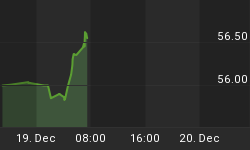U.S. bond yields have surged quite dramatically over the past 12 months, with the 10-year Treasury yield having increased 30 percent while that of the 2-year Treasury has almost doubled. Despite the rapid increase, yields are still well below their historical averages.
If you are like President Trump who isn’t keen on a hawkish Fed, then buckle up for a rough ride since things could be about to get worse for interest rates. Foreign investors are beginning to show signs of fatigue in absorbing U.S. Treasuries, which could lead to a spike in yields in a bid to lure investors.
That group of investors bought just $16.57 billion worth of fixed-rate bond supply in the month of July, less than 10 percent of the $170 billion on offer by the U.S. Treasury Department and the lowest since at least 2009.

(Click to enlarge)

(Click to enlarge)
Source: CNBC
Foreign investors hold about $6.35 trillion of the $15 trillion U.S. Treasury market, about twice as much as they did in 2008. Although that represents 44 percent of the total compared to 56 percent a decade ago (due to the Fed’s buying so much during its QE programs), it’s quite clear that the U.S. economy relies heavily on funds borrowed from foreigners. Related: Trade Wars To Cut Economic Growth By Half
China and Japan are by far the biggest holders of U.S. debt, accounting for more than $2 trillion between them.
Top 15 Foreign Holders of U.S. Treasury Securities

(Click to enlarge)
Source: Statista
China is partly to blame for the slowdown. The country’s uptake of the bonds peaked at $1.3 trillion in 2013, before slumping 15 percent in 2016. It recovered to $1.2 trillion in 2017, before calls from Beijing to slowdown or halt purchases of U.S. securities due to ongoing trade spats started taking a toll. China’s holding of U.S. government debt dropped to $1.179 trillion in June, while Japan’s ownership slipped to $1.030 trillion, the lowest since October 2011.
Other than persistent trade wars, there are other factors at play here. A resurgent dollar has increased hedging costs for foreign holders making U.S. bonds less appealing.
Stock Markets Could Get Hurt
Diminishing appetite for U.S. bonds and rapidly rising yields is bad on several levels. But perhaps none is more alarming as the deletrious effects it could end up having on the stock markets. That’s the case because they coud start competing with the yields offered by equities leading to capital flight from stocks to bonds.
One of equities’ major selling points since the financial crisis has been their higher yields compared to fixed income instruments like bonds. In this case, earnings are considered as the yield of a stock.
The S&P average earnings have been 4.3 percent, considerably higher than the sub-3.0 percent by the 10-year Treasury.
Generally, investors demand a risk premium of not less than 1.5 percent on stocks in relation to bonds. So, it’s quite worrying that the spread has shrunk to the lowest in eight years, rendering stocks increasingly less attractive compared to bonds.

(Click to enlarge)
Source: Bloomberg
The same case applies to commodities like precious metals since they are non-interest yielding.
Related: Are Yield Curve Fears Justified?
But investors can take heart in the fact that domestic investors have been picking up the slack in foreign demand quite capably.
Though it remains unclear if U.S. mutual funds, pension funds, banks and insurers could keep pace if foreign demand keeps falling and federal deficit keeps growing.
Further, it’s quite unlikely that any of the major foreign holders will quickly dump their holdings on account of trade or political tensions. Despite being low by historical norms, U.S. Treasury yields are still higher compared to many markets including the EU and Japan.
Whether you believe that bond yields will keep rising or fall, you can purchase CME or Nasdaq Treasury Futures and place your bets accordingly.
By Alex Kimani for Safehaven.com
More Top Reads From Safehaven.com
















